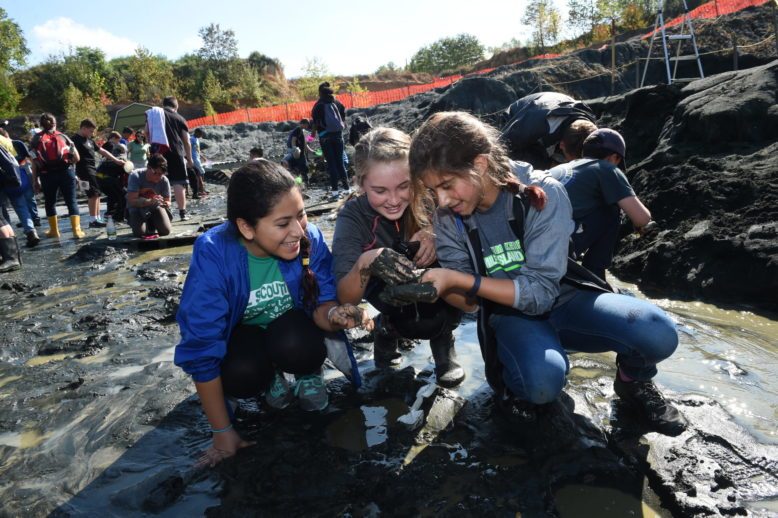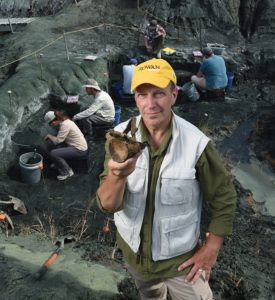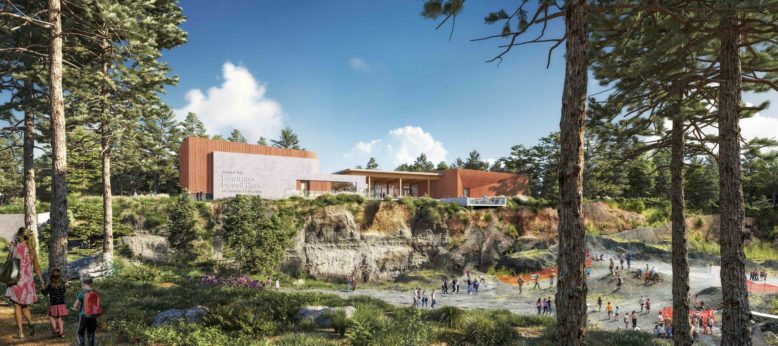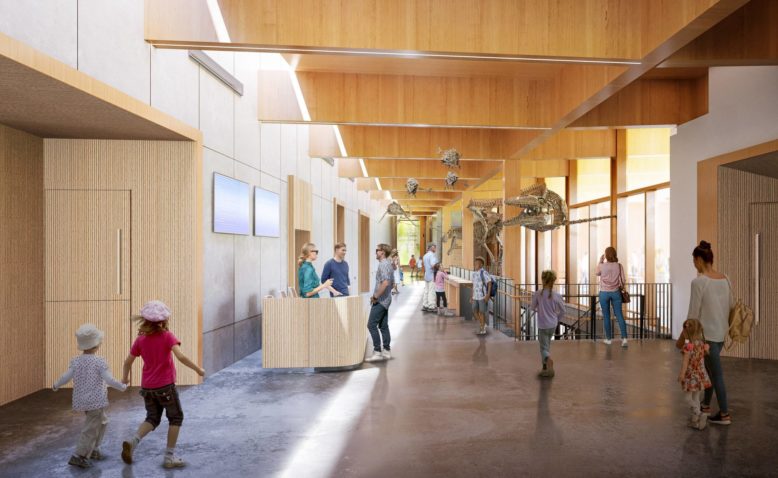
Long before Springsteen, boardwalks and debates over breakfast meats, the likes of Dryptosaurus, Grallator and Hadrosaurus dominated the Garden State. A variety of massive mosasaurs, plesiosaurs, and prehistoric sharks and crocodiles patrolled the waters that would eventually give way to New Jersey’s shores and swamps. The state was—and remains—an ancient hotbed.
Need proof? Look no further than the Jean and Ric Edelman Fossil Park of Rowan University in Mantua Township, where an endless array of fossils are buried beneath a former marl quarry. Already one of the world’s premier paleontological sites, the 65-acre fossil park will be enhanced by a new, state-of-the-art museum, opening on-site over Memorial Day Weekend in 2023.
The park, which is currently closed during construction of the museum, has provided New Jerseyans with an up-close, natural look at the Late Cretaceous Period—or the dinosaurs’ final days—since it opened in 2015. Visitors can dig through the sand and even take home small finds from dinosaurs, sharks, sea turtles, fish, brachiopods, marine snails and more. Larger remnants can be found as well, though they would likely stay put at the park for research purposes.

Paleontologist Kenneth Lacovara, a South Jersey native, has conducted research on five different continents. Courtesy of Rowan University/Craig Terry
“It’s essentially a giant sandbox,” says Kenneth Lacovara, PhD, a renowned paleontologist who is the founding dean of Rowan’s School of Earth & Environment and the founding director of the Edelman Fossil Park. “I’ve never seen a kid who actually tried not find a fossil in the quarry.”
The 44,000-square-foot museum—which Lacovara is also set to run—will overlook the quarry and feature a wide range of exhibitions, reconstructions, hands-on experiences, and live animals with genetic connections to the Late Cretaceous era.
The museum will transport visitors back in time, connecting them with primordial creatures and ecosystems. But the point here is not the past. Rather, this museum is being built with a focus on the future.
“It’s a way to get children excited about science,” says one of the museum’s namesakes, philanthropist and financial adviser Ric Edelman. “For some of them, it will lead to a career. And that will lead to innovations that will make our planet a better place.”
***
Edelman and his wife, Jean, who are both Rowan alumni, jumpstarted the $73 million museum project with a $25 million gift in 2016. Neither has a background in science; they founded Edelman Financial Services in 1987 and are both financial authors and philanthropists.
So why would the couple commit so much money to an endeavor centered on beasts of bygone eras? Ask Edelman that question, and he explains that the donation is more of a long-term investment, one that’s millions of years in the making. The conversation swiftly transitions from the joys of finding fossils to America’s economic power, technological development, and the need to capture and encourage “bright, young minds.”
“They need to be cultivated. They need to be trained,” Edelman says. “The only way someone will enter a career in science or technology is if they have a desire. And the only way they get that desire is by being exposed to science, technology and math when they’re young.”

The Jean and Ric Edelman Fossil Park & Museum, seen here in a rendering, is expected to open Memorial Day weekend in 2023. Photo courtesy of Ennead Architects/KSS
Lacovara agrees. A South Jersey native, his research has taken him to five different continents. His Argentinian discovery of Dreadnoughtus schrani, a colossal herbivore, is considered the best example found of one of the largest creatures ever to grace the earth. He says that uncovering fossils—and realizing you’re the first human to ever lay eyes on something—can be a “transformational experience.”
He hopes the park and museum will inculcate kids with the scientific method, which can then be applied to all kinds of careers, as well as everyday life.“I like to think we’re using fossils and discovery to grow better citizens for our state,” Lacovara says. Edelman, meanwhile, says the site will be a gateway to “solving the world’s biggest problems.”
One particular issue that immediately comes to Lacovara’s mind is our “perilous environmental future.” He hopes that simply sharing the “cautionary tale” of the dinosaurs’ extinction will have a positive impact on visitors.
[RELATED: Discover New Jersey’s Museums]
“The dinosaurs dominated the earth’s terrestrial ecosystems for 165 million years. They were worldwide, they were biodiverse, they were doing just fine. And then, literally in a day, an asteroid wipes them out,” Lacovara says. “The world didn’t have to have dinosaurs, and maybe it doesn’t have to have humans. We have put ourselves in a very precarious situation with the climate crisis and the biodiversity crisis. There is still hope, and we plan to give people hope and ways that they can act to help ensure a better, cleaner, healthier tomorrow, but action is needed by everybody. So we will take people through that entire story in our exhibits.”
The paleontologist then dusts off a favorite quote. “The further back you look, the further ahead you can see,” Lacovara says, citing Winston Churchill.
“The dinosaurs are the hook,” he adds of the museum, “but really, it’s about what can we learn from the past.”
***
New Jersey’s history is rich with dinosaurs, and their presence can be felt at museums and sites all over the state. The most famous is Hadrosaurus foulkii, the official state dino. Remains of the duck-billed plant-eater were discovered by William Parker Foulke in Haddonfield in 1858 and became the world’s first nearly complete dinosaur skeleton.
Amateurs and professionals alike can make their own discoveries at the fossil park in Mantua, once construction on the museum is complete. Few other locations provide the chance to find and keep fossils, and most require labor-intensive methods, such as splitting hard shale. Here, anyone can sift through the sand and walk away with a legitimate paleontological discovery.
“There are very few dig sites in the world. They are almost entirely in remote locations—the Artic, Montana, China, Chile, ” Edelman says. “And even at relatively close sites, they’re off-limits to anybody except researchers. The ability for schoolchildren all the way up to their grandparents to be able to go into the park 365 days a year and dig for fossils is unprecedented.”

Rowan University’s Jean & Ric Edelman Fossil Park & Museum, seen here in a rendering, will feature a wide range of exhibitions, reconstructions, hands-on experiences, and live animals, in addition to a dig site that is open to the public. Photo courtesy of Ennead Architects/KSS
That is why Edelman and Lacovara believe the fossil park and museum will “do wonders for the economy of southern New Jersey.” They predict it will attract an international crowd; Lacovara says he has already received inquiries from tour groups in India, Germany and China. Mantua’s proximity to Philadelphia, New York City and Washington, D.C., has the site anticipating hundreds of thousands of visitors each year. Lacovara says such numbers should create jobs, cash flow and visibility for the surrounding communities, and he also sees the park and museum luring prospective college students from across the country.
“I like to think of the fossil park as Rowan’s Division I football team,” Lacovara says. “In five years, if you’re a kid in California that decides to go to Rowan University, there’s a good chance it’s going to be because of the fossil park.”
Lacovara’s dreams do not stop there. He does not hesitate to make a case for the museum and park becoming a future United Nations World Heritage Site, joining the likes of Stonehenge, the Egyptian Pyramids and the Grand Canyon. “It’s of that significance,” he says, even though the museum is over a year away from opening. “This is a unique site on the planet,” the global explorer continues. “There’s nowhere else in the world that you can see what we have there.”
Edelman, eager to see his investment unfold, echoes a similar sentiment.
“You can find a zoo or an aquarium in virtually every city,” he says. “Every city has its own sense of culture and history. But there is nowhere in the world that you’ll be able to experience this.
“Except in South Jersey.”
